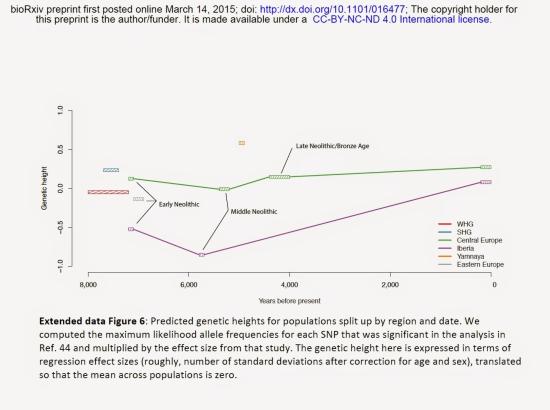Source - http://dienekes.blogspot.fr/

A new preprint on the bioRxiv studies the same data as the recent Haak et al. paper, but focuses on natural selection in Europe. Until recently, selection could only be studied by looking at modern populations, but since selection is genetic change over time effected by the environment, it's possible that studies like this will be the norm in the future.
The new study seems to confirm the results of Wilde et al.on steppe groups, as the Yamnaya had a very low frequency of the HERC2 derived "blue eye" allele and a lower frequency of the SLC45A2 "light skin" allele than any modern Europeans. The Yamnaya seem to have been fixed for the other SLC24A5 "light skin" allele which seems to have been at high frequency in all ancient groups save the "Western Hunter Gatherers".
It seems that light pigmentation traits had already existed in pre-Indo-European Europeans (both farmers and hunter-gatherers) and so long-standing philological attempts to correlate them with the arrival of light-pigmented Indo-Europeans from the steppe (or indeed anywhere), and to contrast them with darker pre-Indo-European inhabitants of Europe were misguided. If anything, it seems that the "fairest of them all" were the Scandinavian hunter-gatherers, and a combination of light/dark pigmentation was also present in Neolithic farmers and Western Hunter Gatherers in various combinations.
It also seems that both the theory that lactose tolerance started with LBK farmers and the theory that it came to Europe from milk-drinking steppe Indo-Europeans were wrong, as this trait seems to be altogether absent in European hunter-gatherers, farmers, and Yamnaya, and make a very timid appearance in the Late neolithic/Bronze Age before shooting up in frequency to the present.

Another new development is the ability to predict "genetic height" from ancient DNA. I think this may be a little bit superfluous as you can predict "actual height" by measuring long bone lengths. On the other hand, actualized height depends not only on genetics but also on diet, disease, etc., so it's useful to look at genetic changes in such polygenic traits directly.
A big surprise was the presence of the derived EDAR allele in Swedish hunter-gatherers. This allele is very rare in modern Europeans and seems to have pleiotropic effects in East Asians. This raises the question why this allele (that was so successful in East Asians), never "took hold" in Europeans. One possibility is that it never provided an advantage to Europeans (I don't think anyone really knows what it's actuallygood for). Another is that Swedish hunter-gatherers simply didn't contribute much ancestry to modern Europeans and so the allele never got the chance to rise in frequency by much.
bioRxiv http://dx.doi.org/10.1101/016477
Eight thousand years of natural selection in Europe
Iain Mathieson et al.
The arrival of farming in Europe beginning around 8,500 years ago required adaptation to new environments, pathogens, diets, and social organizations. While evidence of natural selection can be revealed by studying patterns of genetic variation in present-day people, these pattern are only indirect echoes of past events, and provide little information about where and when selection occurred. Ancient DNA makes it possible to examine populations as they were before, during and after adaptation events, and thus to reveal the tempo and mode of selection. Here we report the first genome-wide scan for selection using ancient DNA, based on 83 human samples from Holocene Europe analyzed at over 300,000 positions. We find five genome-wide signals of selection, at loci associated with diet and pigmentation. Surprisingly in light of suggestions of selection on immune traits associated with the advent of agriculture and denser living conditions, we find no strong sweeps associated with immunological phenotypes. We also report a scan for selection for complex traits, and find two signals of selection on height: for short stature in Iberia after the arrival of agriculture, and for tall stature on the Pontic-Caspian steppe earlier than 5,000 years ago. A surprise is that in Scandinavian hunter-gatherers living around 8,000 years ago, there is a high frequency of the derived allele at the EDAR gene that is the strongest known signal of selection in East Asians and that is thought to have arisen in East Asia. These results document the power of ancient DNA to reveal features of past adaptation that could not be understood from analyses of present-day people.